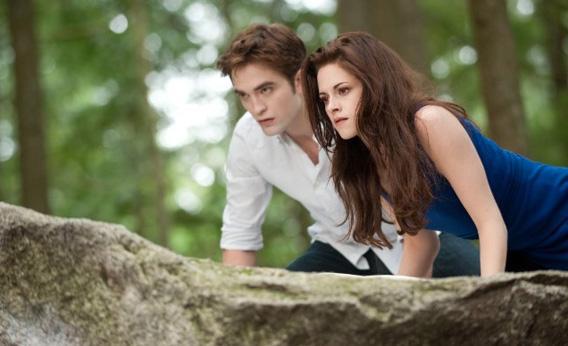The very title Breaking Dawn, Part 2 hints at what the movie, sadly, reveals to be the case: The Twilight franchise has overstayed its welcome. Splitting the last book in Stephenie Meyer’s teen-vampire series into two separate movies may have been a wise business decision—with guaranteed throngs of adoring Twihards willing to go back for multiple viewings, why not eke out an extra sequel?—but it leaves the last film in the series with no place to go.
Of course, one might argue that none of the four previous Twilight films have had any place to go. The world of Twilight is intermittently action-packed, but dramatically static. The story’s central love triangle—mortal Bella, vampire Edward, werewolf Jacob—exists in a state of unconsummated tension on all sides: The purpose of the movies is, in essence, to contemplate the mystery of this holy trinity. This curiously placid, devotional quality is part of what I liked about the first four Twilight films: They lulled the viewer into a somnolent daze that mimicked their spacey heroine’s perpetual love-fog. Breaking Dawn, Part 2, (directed, like its predecessor, by Bill Condon), gets the “somnolent daze” feeling right, but with the sexual heat gone from the center of the story now that Bella and Edward have done the deed, the only thing left for viewers to contemplate is the sanctity of the nuclear family (which, compared to the lurid joys of human-on-vampire dry humping, seems a pallid prize indeed).
When we last saw Bella (Kristen Stewart), she had finally been changed into a vampire by her long-resistant undead husband, Edward Cullen (Robert Pattinson) in a last-ditch effort to save her from dying while giving birth to their monstrously fast-growing half-vampire/half-human child, Renesmée. (It’s a portmanteau of her grandmothers’ first names, OK?) Breaking Dawn, Part 1 ended on the image of Bella’s eyes popping open on the delivery table, ablaze with a new, unquenchable fire, the irises changed from brown to a coppery red. As Breaking Dawn, Part 2 begins, we look at the world through those transformed eyes: the pollen on a flower, the down on a bumblebee, all appear in extra-sharp relief. Damsel-in-distress Bella has now become superfast, superstrong, and tireless—after she and Edward have vampire sex for the first time, she observes with wonder that she’ll no longer need sleep in between their marathon sex bouts. These are conducted in a Thomas Kinkade-esque cottage that the Cullen coven have provided for the newlyweds behind their more stark, modern house.*
In a plot development that’s consistent with the Twilight series’ ongoing propensity for unacknowledged incestuous creepiness, Bella’s lupine ex-suitor Jacob (Taylor Lautner) has now “imprinted” on her daughter (not in that way! He’s just bound by werewolf instinct to protect her from harm! Renesmée, that is!). This arrangement, by dissolving the sexual tension between Jacob and Bella, allows the once-dangerous Edward/Jacob rivalry to be subsumed into a stable family unit, with Lautner’s character as a kind of neutered babysitter.
All in all, life as a vampire is pretty sweet, even if Bella has to lie to her father (a severely underused Billy Burke) about her new existential status. But then the Volturi—a kind of Vatican council of vampire high priests, headed up by an impish, scene-stealing Michael Sheen—get a tip about the birth of the half-breed vampire baby and determine that the entire Cullen family must be destroyed.
About an hour in, it starts to occur to you that, for creatures capable of moving through space so quickly they’re perceptible only as gray blurs, the Volturi are taking their sweet time getting from Italy to Forks, Wash. The Cullen clan spends eons standing around in front of modern-art installations, trading fretful observations about the impending vampire civil war. They enlist a militia of rebel vampires from around the world to their side (including a pair of disgruntled immortals still smarting from the Volturi’s seizure of their castles 1,500 years ago) and even get some backup from their erstwhile enemies, the werewolves. By the time the great vampire showdown finally got started, I was good and done with Breaking Dawn, Part 2. But the big action scene is so campily over the top—with one twist so unforeseeable—that it sent me out on a burst of grudging goodwill.
The film’s endlessly drawn-out ending, with its multiple spoken and written iterations of the book’s last word, “forever,” over an image of the matte-skinned, cultishly beatific Cullens, may be the scariest moment in the whole pulpy yet vital Twilight series—a teenage girl’s fantasy of perfect domestic contentment, frozen in time and doomed to last forever.
Correction, Nov. 15, 2012: This review originally misspelled the last name of Thomas Kinkade. (Return to the corrected sentence.)
